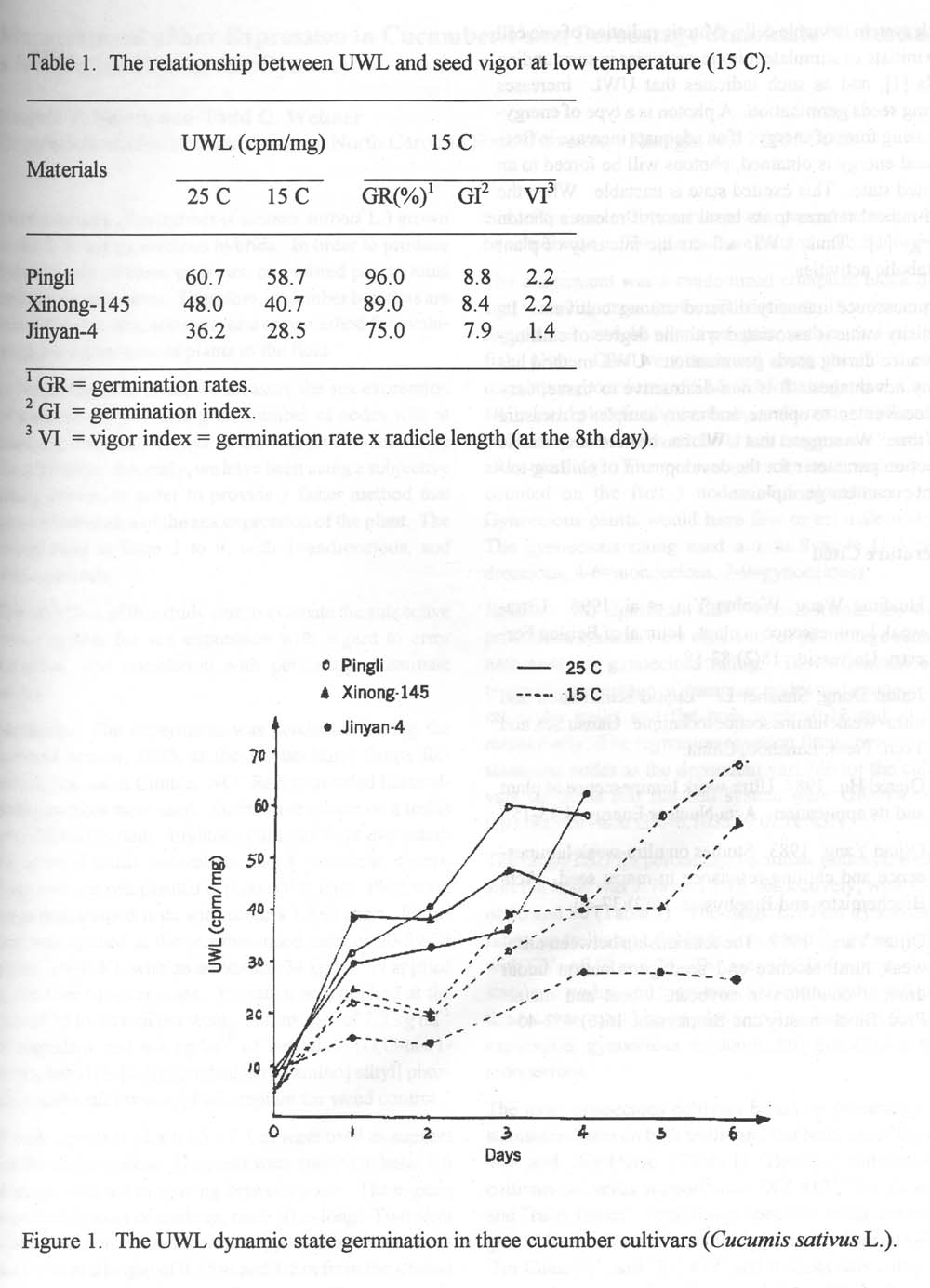Cucurbit Genetics Cooperative Report 20:4-6 (article 3) 1997
Yu Shuancang, Cui Hongwen and Yuan Yuxiang
Department of Horticulture, Northwestern Agricultural University, Yangling, Shaanxi 712100 P.R. China
Lu Jinyin
Department of Basic Science, Northwestern Agricultural University, Yangling , Shaanxi 712100 P.R. China
Phytoluminescence analysis (the technique of phytoultramicroanalysis) was developed in the 1970s. Ultra-weak luminescence (UWL) is highly susceptible to changes in plant metabolic activities and environment. It has been proven that UWL acts as a reliable index for stress-tolerance evaluation in different plant species [3, 5]. Other evidence has suggested that UWL may be useful for the identification of chilling-resistance in some crops (e.g., maize) [4]. The possible association of UWL and the degree of chilling-tolerance in cucumber is worth closer inspection. The UWL of various cucumber cultivar seeds during germination at normal temperature(25C) and low temperature (15°C) is described herein. Such a technique, if accurate and consistent could provide for a new selection tool for the development of chilling-tolerance germplasm in cucumber.
Materials and Methods. Three cucumber cultivars with different chilling-tolerances were used [‘Pingli’ (chilling- tolerant), ‘Xinong- 145’ (moderately tolerant) and ‘Jinyan-4’ (chilling- susceptible)]. Seeds were placed in culture dishes lined with two layers of filter paper. These dishes were transferred to an incubator at 25°C or 15°C. The number of germinated seeds was counted daily. Five uniform samples of germinating seeds were taken for measurement by UWL using an LS-9800 Liquid Scintillation Counter (Amer. Beckman Co.). At 15°C, UWL was measured for six days, and at 25°C for four days (cotyledons had turned green at the fourth day at normal temperature due to quenching effects). On the 8th day, radicles were measured and the experiment was terminated. All tests were replicated three times. UWL is expressed as luminescence intensity per milligram fresh weight.
Results. UWL has a dynamic state in germination cucumber seeds. UWL in dry seeds was weak. There was a sharp increase recorded during the seeds’ hydration. With seeds imbibing and germinating, the metabolic activities intensified, and the luminescence signal became stronger.
Luminescence intensity at 15°C was lower than that at 25°C. Thus, low temperature had an inhibitive effect on luminescence. The UWL of dry seeds among the cultivars examined was not different. However, cultivar germinated seeds at 25°C and 5 to 6 days-old germinated seeds at 15°C. The most chilling-tolerant cultivar, ‘Pingli’, had the highest value (Fig. 1).
There appeared to be a relationship between UWL value and chilling-tolerance of germinating seeds. UWL intensity of 3-day-old germinated seeds at normal temperature (25°C), 5-day-old seeds at low temperature (15°C), and the index of seed vigor at (15°C) is shown in Table 1. The value of UWL (at 25°C or 15°C) was consistent with the germination rate (GR), germination vigor (GI) and vigor index (VI) at low temperature (15°C), and there was a significant difference detected between cultivars in UWL. Our results showed that UWL of germinating seeds (3-day-old at 25°C, and 5-day-old at 15°C) can act as a reliable index for identification of chilling-tolerant cucumber germplasm (Table 1).
Discussion. Plant UWL is a type of ultra-weak microphoton radiation given off by plants which is coupled with their development [2]. Its potential application to agriculture is therefore meaningful.
UWL occurs in cucumber seeds. This can be explained by the auto-oxidation of unsaturated fatty acids and oxidative enzymatic reaction of fatty acids which will produce peroxide-free-radicals in seeds during storage. Photons are released when these radicals accumulate. During the imbibition of the seeds, the accumulation of radicals will accelerate, and the luminescence intensity will be enhanced dramatically. In germinating seeds, UWL is derived from a cell’s during radiation mitosis. It had been thought that plant UWL is a negative feedback system in viable cells. Mitotic radiation of one cell can initiate or stimulate mitotic activities in surrounding cells [1], and as such indicates that UWL increases during seeds germination. A photon is a type of energy-releasing form of energy. If an adequate increase in free-radical energy is obtained, photons will be forced to an excited state. This excited state is unstable. When the free-radical returns to its basal state, it releases photon energy [1]. Thus, UWL reflects the intensity of plant metabolic activities.
Luminescence intensity differed among cultivars. Its intensity value is associated with the degree of chilling-tolerance during seeds germination. UWL method has many advantages. It is non-destructive to tissue, easy and convenient to operate, and many samples to measure one time. We suggest that UWL can be used as a reliable selection parameter for the development of chilling-tolerant cucumber germplasm.
Table 1. The relationship between UWL and seed vigor at low temperature (15°C).
UWL (cpm/mg) |
15°C |
||||
Materials |
25°C |
15°C |
GR (%)1 |
GI2 |
VI3 |
| Pingli | 60.7 | 58.7 | 96.0 | 8.8 | 2.2 |
| Xinong-145 | 48.0 | 10.7 | 89.0 | 8.4 | 2.2 |
| Jinyan-4 | 36.2 | 28.5 | 75.0 | 7.9 | 1.4 |
1GR = germination rates.
2 GI = germination index.
3 VI = vigor index = germination rate x radicle length (at the 8th day).
Figure 1. The UWL dynamic state germination in three cucumber cultivars (Cucumis sativus L.).

Literature Cited
- Huafang Wang, Wenlun Yin, et al. 1996. Ultra-weak luminescence in plant. Journal of Beijing Forestry University. 18(2):83-88.
- Jialun Dong, Shuzhei Li. Liquid scintillation and ultra-weak luminescence technique. Gansu Sci. and Tech. Press. Lanzhou, China.
- Quanxi Hu. 1984. Ultra-weak luminescence of plant and its application. Acta Nuclear Energy. 4:13-15.
- Qijian Yang. 1983. Studies on ultra-weak luminescence and chilling-resistance in maize seed. Acta Biochemistry and Biophysics. 16(2):37-40.
- Qijian Yang. 1989. The relationship between ultra-weak luminescence and seed germination under drought condition in soybean, wheat and maize. Proc. Biochemistry and Biophysics. 16(6): 452-454.